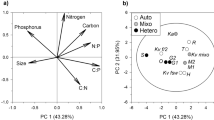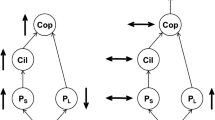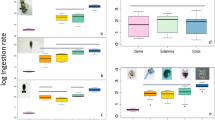Copepods, cladocerans and tunicates form major groups of herbivorous mesozooplankton. The former two are found in fresh and marine waters, while the latter are restricted to marine systems. In the present review, we compile existing ecophysiological knowledge about between-group differences in metabolic and reproductive rates, feeding selectivity and elemental composition. From this, we derive predictions about their impact on the lower trophic levels (phytoplankton and microbial food web) and predictions about their prevalence under different ecological conditions (e.g. nutrient richness, Si : N ratio, phytoplankton size structure and top-down control).
Similar content being viewed by others
REFERENCES
Acuna J. L. (2001) Pelagic tunicates: why gelatinous? American Naturalist (in press)
Andersen T. & Hessen D. O. (1991) Carbon, nitrogen and phosphorous content of freshwater zooplankton. Limnology and Oceanography 36: 807–814.
Armstrong R. A. (1994) Grazing limitation and nutrient limitation in marine ecosystems: Steady state solutions of an ecosystem model with multiple food chains. Limnology and Oceanography 39: 597–608.
Barber R. T. & Smith R. L. (1981) Coastal upwelling ecosystems. In: Analysis of Marine Ecosystems. (ed. A. R. Longhurst) pp. 33–68. Academic Press, London.
Bautista B., Harris R., Tranter P. R. & Harbour D. (1992) In situ copepod feeding and grazing during a spring bloom dominated by Phaeocystis in the English channel. Journal of Plankton Research 14: 691–703.
Bienfang P., Harrison P. G. & Quarmby L. M. (1982) Sinking rate response to depletion of nitrate, silicate and phosphate in four marine diatoms. Marine Biology 67: 295–302.
Bone Q. (1998) The Biology of Pelagic Tunicates. Oxford University Press, Oxford.
Bone Q., Braconnot J. C., Carre C. & Ryan K. P. (1997) On the filter-feeding of Doliolum (Tunicata: Thaliacea). Journal of Experimental Marine Biology and Ecology 179: 179–193.
Brendelberger H., Herbeck M., Lang H. & Lampert W. (1986) Daphnia’s filters are not solid walls. Archiv für Hydrobiologie 107: 197–202.
Brooks J. L. (1968) The effect of prey size selection by lake planktivores. Systematic Zoology 17: 272–291.
Cadée G. C. (1986) Recurrent and Changing Seasonal Patterns of Phytoplankton in the Westernmost Inlet of the Wadden Sea, the Marsdiep, since 1973. In: Water pollution research report 12. Commission of the European Community. (ed. C. Lancelot, G. Billen & H. Bath) pp. 105–112. European Community, Luxembourg.
Cadée G. C. & Hegeman J. (1991) Historical phytoplankton data from the Marsdiep. Hydrobiological Bulletin 24: 111–119.
Campbell C. E. (1991) Prey selectivity of threespine sticklebacks (Gasterosteus aculeatus) and phantom midge larvae (Chaoborus spp.) in Newfoundland lakes. Freshwater Biology 25: 155–167.
Caron D. A., Goldman J. C. & Dennett M. R. (1988) Experimental demonstration of the roles of bacteria and bacterivorous protozoa in plankton nutrient cycles. Hydrobiologia 159: 27–40.
Checkley D. R. M. (1986) Nitrogen limitation of zooplankton production and its effect on the marine nitrogen cycle. Archiv für Hydrobiologie Beiheft 21: 103–113.
Deibel D. (1998) The abundance, distribution, and ecological impact of doliolids. In: The Biology of Pelagic Tunicates. (ed. Q. Bone) pp. 171–186. Oxford University Press, Oxford.
Deibel D., Cavaletto J. F., Riehl M. & Gardener W. S. (1992) Lipid and lipid class content of the pelagic tunicate Oikopleura vanhoeffeni. Marine Ecology Progress Series 88: 297–302.
Deibel D. & Powell C. V. L. (1987) Comparison of the ultrastructure of the food concentrating filter of two appendiculariens. Marine Ecology Progress Series 39: 81–85.
DeMott W. R. (1988) Discrimination between algae and artificial particles by freshwater and marine copepods. Limnology and Oceanography 33: 397–408.
Demott W. R. (1990) Retention efficiency, perceptual bias, and active choice as mechanisms of food selection by suspension feeding zooplankton. In: Behavioural Mechanisms of Food Selection. (ed. R. N. Hughes) pp. 569–594. Springer, New York.
Dobberfuhl D. R. & Elser J. J. (2000) Inferring food quality thresholds from first principles: the influence of life history and assimilation of C and P. Verhandlungen der Internationalen Vereinigung für Limnologie 27: 834–838.
Egge J. K. & Jacobsen A. (1997) Influence of silicate on particulate carbon production in phytoplankton. Marine Ecology Progress Series 147: 219–230.
Elser J. J., Dobberfuhl D., MacKay N. A. & Schampel J. H. (1996) Organism size, life history, and N. P stoichiometry: toward a unified view of cellular and ecosystem processes. Bioscience 46: 674–684.
Elser J. J. & Urabe J. (1999) The stoichiometry of consumer-driven nutrient recycling: theory, observations, and consequences. Ecology 80: 735–751.
Escaravage V., Prins T. C., Smaal A. C. & Peeters J. C. H. (1996) The response of phytoplankton communities to phosphorous input reductions in mesocosm experiments. Journal of Experimental Marine Biology and Ecology 198: 55–79.
Geller W. & Müller H. (1981) The filtration apparatus of Cladocera: filter mesh-sizes and their implications on food selectivity. Oecologia 49: 316–321.
Gismervik I. (1997) Stoichiometry of some marine planktonic cladocerans. Journal of Plankton Research 19: 279–285.
Gismervik I. & Andersen T. (1997) Prey switching by Acartia clausi: experimental evidence and implications of intraguild predation assessed by a model. Marine Ecology Progress Series 157: 247–259.
Gliwicz Z. M. (1975) Effects of zooplankton grazing on photosynthetic activity and composition of phytoplankton. Verhandlungen der Internationalen Vereinigung für Limnologie 19: 1490–1497.
Gliwicz Z. M. (1977) Food size selection and seasonal succession of filter feeding zooplankton in a eutrophic lake. Ecologia Polska 25: 179–225.
Gliwicz Z. M. & Siedlar E. (1980) Food size selection and algae interfering with food collection in Daphnia. Archiv für Hydrobiologie 88: 155–177.
Goldman J. C., McCarthy J. J. & Peavey D. G. (1979) Growth rate influence on the chemical composition of phytoplankton in oceanic waters. Nature 279: 210–215.
Gophen M. & Geller W. (1984) Filter mesh size and food particle uptake by Daphnia. Oecologia 64: 408–412.
Granéli E., Carlsson P., Olsson P., Sundström B., Granéli W. & Lindahl O. (1989) From anoxia to fish poisoning: the last ten years of phytoplankton blooms in Swedish marine waters. In: Novel Phytoplankton Blooms. (ed. E. M. Cosper, V. M. Bricelj, E. J. Carpenter) pp. 407–427. Springer, New York.
Hairston N. G., Smith F. E. & Slobodkin L. B. (1960) Community structure, population control and competition. American Naturalist 94: 421–425.
Hansen P. J., Bjornsen P. K. & Hansen B. W. (1997) Zooplankton grazing and growth: scaling within the 2–200 μm body size range. Limnology and Oceanography 42: 687–704.
Harbison G. R. (1992) The gelatinous inhabitants of the ocean interior. Oceanus 35: 18–23.
Harbison G. R. (1998) The parasites and predators of thaliacea. In: The Biology of Pelagic Tunicates. (ed. Q. Bone) pp. 184–214. Oxford University Press, Oxford.
Haskell A. G. E., Hofmann E. E., Pfaffenhöfer G. A. & Verity P. (1999) Modeling the effects of doliolids on the plankton community structure of the southeastern US continental shelf. Journal of Plankton Research 21: 1725–1752.
Hasset R. P. B., Cardinale B., Stabler L. B. & Elser J. J. (1997) Ecological stoichiometry of N and P in pelagic ecosystems: comparison of lakes and oceans with emphasis on zooplankton–phytoplankton interactions. Limnology and Oceanography 42: 648–662.
Hessen D. O. & Lyche A. (1991) Inter- and intraspecific variations in zooplankton element composition. Archiv für Hydrobiologie 121: 343–353.
Ianora A., Miralto A. & Poulet S. A. (1999) Are diatoms good or toxic for copepods? Reply to comment by Jonasdottir et al. Marine Ecology Progress Series 177: 305–308.
Ianora A., Poulet S. A. & Miralto A. (1995) A comparative study of the inhibitory effect of diatoms on the reproductive biology of the copepod Temora stylifera. Marine Biology 121: 533–539.
Ikeda T. (1985) Metabolic rates of epipelagic marine zooplankton as a function of body mass and temperature. Marine Biology 85: 1–11.
Johnsen S. (2000) Transparent animals. Scientific American 260: 63–71.
Jonasdottir S. H., Kiørboe T., Tang K. W.et al. (1998) Role of diatoms in copepod production: good, harmless or toxic. Marine Ecology Progress Series 172: 305–308.
Kasprzak P. & Koschel R. (2000) Lake trophic state, community structure and biomass of crustacean zooplankton. Verhandlungen der Internationalen Vereinigung für Limnologie 27: 773–777.
Katechakis A. (1999) Nischenüberlappung zwischen herbivorem gelatinösen und Crustaceen-Zooplankton im NW-Mittelmeer (Catalanisches Meer). Diploma Thesis, University Kiel, Kiel, Germany.
Katechakis A., Stibor H., Sommer U. & Hansen T. (2002) Changes in the phytoplankton community and in the microbial food web of Blanes Bay (Catalan Sea, NW-Mediterranean) under prolonged grazing pressure by doliolids (Tunicata), cladocerans or copepods (Crustacea). Marine Ecology Progress Series (in press).
Kiørboe T., Saiz E. & Viitasalo M. (1996) Prey switching behaviour of the planktonic copepod Acartia tonsa. Marine Ecology Progress Series 143: 65–75.
Kleppel G. S. (1993) On the diet of calanoid copepods. Marine Ecology Progress Series 99: 183–195.
Lampert W. (1978) Climatic conditions and planktonic interactions as factors controlling the regular succession of spring algal bloom and extremely clear water in Lake Constance. Verhandlungen der Internationalen Vereinigung für Limnologie 20: 969–974.
Lampert W. (1988) The relationship between zooplankton biomass and grazing: a review. Limnologica 19: 11–20.
Lampert W. (1993) Phenotypic plasticity of the size at first reproduction in Daphnia: the importance of maternal size. Ecology 74: 1455–1466.
Lampert W. & Muck P. (1985) Multiple aspects of food limitation in zooplankton communities: The Daphnia-Eudiaptomus example. Archiv für Hydrobiologie Beiheft 21: 311–322.
Li W. K. W., Zohary T., Jacobi Y. Z. & Wood A. M. (1993) Ultraphytoplankton in the eastern Mediterranean Sea: towards deriving phytoplankton biomass from flow cytometric measures of abundance, fluorescence and light scatter. Marine Ecology Progress Series 102: 79–87.
Lindell D. & Post A. F. (1995) Ultraphytoplankton succession is triggered by deep winter mixing in the Gulf of Aqaba (Eilat), Red Sea. Limnoloy and Oceanography 40: 1130–1141.
Lubchenco J. (1978) Plant species diversity in a marine intertidal community: importance of herbivore food preferences and algal competitive ability. American Naturalist 112: 23–39.
Lynch M., Wieder L. & Lampert W. (1986) Measurement of the carbon balance in Daphnia. Limnology and Oceanography 31: 17–33.
McNaughton S. J. (1985) Ecology of a grazing system: the serengeti. Ecological Monographs 53: 291–320.
Maestrini S. Y. & Graneli E. (1991) Environmental conditions and ecophysiological mechanisms which led to the 1988 Chrysochromulina polylepis bloom. Oceanologica Acta 14: 397–413.
Nejstgaard J. C., Gismervik I. & Solberg P. T. (1997) Feeding and reproduction by Calanus finnmarchicus, and microzooplankton grazing during mesocosm blooms of diatoms and the coccolithophore Emiliana huxleyi. Marine Ecology Progress Series 147: 197–217.
Paffenhöfer G. A. (1984) Food ingestion by the marine planktonic copepod Paracalanus in relation to abundance and size distribution of food. Marine Biology 80: 323–333.
Paffenhöfer G. A. & Orcutt J. D. (1986) Feeding, growth and food conversion of the marine cladoceran Penilia avirostris. Journal of Plankton Research 8: 741–754.
Peters R. H. (1983) The Ecological Implications of Body Size. Cambridge University Press, Cambridge.
Pomeroy L. R. (1974) The ocean foodweb, a changing paradigm. Bioscience 24: 499–504.
Ponde D. & Sargent J. R. (1989) Lipid composition of the pelagic tunicate Dolioletta gegenbauri. Journal of Plankton Research 20: 169–174.
Power M. E. (1992) Top down and bottom up forces in food webs. Do plants have promacy? Ecology 73: 733–746.
Radach G. & Berg J. (1986) Trends in den Konzentrationen der Nährstoffe und des Phytoplanktons in der Deutschen Bucht. Berichte der Biologischen Anstalt Helgoland 2: 1–165.
Raven J. A. (1986) Physiological consequences of extremely small size for autotrophic organisms in the sea. Canandian Bulletin of Fisheries and Aquatic Sciences 214: 1–70.
Schneider G. (1992) A comparison of carbon specific respiration rates in gelatinous and non gelatinous zooplankton: a search for general rules in zooplankton metabolism. Helgoländer Meeresuntersuchungen 46: 377–388.
Schöllhorn E. & Granéli E. (1996) Influence of different nitrogen to silica ratios and artificial mixing on the structure of a summer phytoplankton community from the Swedish west coast (Gullmar Fjord). Journal of Sea Research 35: 159–167.
Smayda T. J. (1990) Novel and nuisance blooms in the sea: evidence for a global epidemic. In: Toxic Marine Phytoplankton. (eds E. Granéli, B. Sundström, L. Edler, D. M. Anderson) pp. 29–41. Elsevier, Amsterdam.
Sommer U. (1983) Nutrient competition between phytoplankton species in multispecies chemostat experiments. Archiv für Hydrobiologie 96: 399–416.
Sommer U. (1986) The periodicity of phytoplankton in Lake Constance (Bodensee) in comparison to other deep lakes of central Europe. Hydrobiologia 138: 1–7.
Sommer U. (1992) Phosphorous limited Daphnia: intraspecific facilitation instead of competition. Limnology and Oceanography 37: 966–973.
Sommer U. (1994) The impact of light intensity and daylength on silicate and nitrate competition among marine phytoplankton. Limnology and Oceanography 39: 1680–1688.
Sommer U. (1996) Plankton ecology: two decades of progress. Naturwissenschaften 38: 293–301.
Sommer U. (1998a) From algal competition to animal production: enhanced ecological efficiency of Brachionus with a mixed diet. Limnology and Oceanography 43: 1393–1396.
Sommer U. (1998b) Biologische Meereskunde. Springer, Berlin.
Sommer U. (1999a) A comment on the proper use of nutrient ratios in microalgal ecology. Archiv für Hydrobiologie 146: 55–64.
Sommer U. (1999b) The impact of herbivore type and grazing pressure on benthic microalgal diversity. Ecology Letters 2: 65–69.
Sommer U. (2000) Scarcity of medium-sized phytoplankton in the northern Red Sea explained by strong bottom-up and weak top-down control. Marine Ecology Progress Series 197: 19–25.
Sommer U., Gliwicz Z. M., Lampert W. & Duncan A. (1986) The PEG-model of seasonal succession of planktonic events in fresh waters. Archiv für Hydrobiologie 106: 433–471.
Sommer U., Sommer F. & Santer Bet al. (2001b) Complementary impact of copepods and cladocerans on phytoplankton. Ecology Letters 4: 545–550.
Sommer U., Stibor H., Katechakis A., Sommer F. & Hansen T. (2001a) Pelagic food web configurations under different levels of nutrient richness and their implications for the ratio fish production: primary production. Hydrobiologia (in press)
Sommer F., Stibor H., Sommer U. & Velimirov B. (2000) Grazing by mesozooplankton from Kiel Bight, Baltic Sea, on different sized algae and natural seston size fractions. Marine Ecology Progress Series 199: 43–53.
Sterner R. W. & Schulz K. L. (1998) Zooplankton nutrition: recent progress and reality check. Aquatic Ecology 32: 261–279.
Stibor H. (1992) Predator induced life history shifts in a freshwater cladoceran. Oecologia 92: 162–165.
Stibor H. & Lampert W. (2000) Components of additive variance in life-history traits of Daphnia hyalina: seasonal differences in the response to predator signals. Oikos 88: 129–138.
Stibor H. & Lüning J. (1994) Predator induced phenotypic variation in the pattern of growth and reproduction in Daphnia hyalina. Functional Ecology 8: 97–101.
Stockner J. G. & Antia N. J. (1986) Algal picoplankton from marine and freshwater ecosystems: a multidisciplinary perspective. Canadian Journal of Fisheries and Aquatic Sciences 43: 2472–2503.
Strong D. R. (1992) Are trophic cascades all wet? Differentiation and donor control in speciose ecosystems. Ecology 73: 747–754.
Suttle C. A., Stockner J. G. & Harrison P. J. (1987) Effects of nutrient pulses on community structure and cell size of a freshwater phytoplankton assemblage in culture. Canadian Journal of Fisheries and Aquatic Sciences 44: 1768–1774.
Tilman D. (1982) Resource Competition and Community Structure. Princeton University Press, Princeton.
Tilman D., Kiesling R., Sterner R. W., Kilham S. S. & Johnson F. A. (1986) Green, blue-green and diatom algae: taxonomic differences in competitive ability for phosphorous, silicon and nitrogen. Archiv für Hydrobiologie 106: 473–485.
Townsend C. R., Winfield J. J., Parson G. & Cryer M. (1986) The response of young roach Rutilus rutilus to seasonal changes in abundance of prey. A field demonstration of switching. Oikos 46: 372–378.
Turpin D. H. & Harrison P. J. (1980) Cell size manipulation in natural, marine, planktonic diatom communities. Canadian Journal of Fisheries and Aquatic Sciences 37: 1193–1195.
Urabe J. & Watanabe Y. (1992) Possibility of N or P limitation for planktonic cladocerans: an experimental test. Limnology and Oceanography 37: 244–251.
Verity P. G. & Smetacek V. (1996) Organism life cycles, predation, and the structure of marine pelagic systems. Marine Ecology Progress Series 130: 277–293.
Author information
Authors and Affiliations
Corresponding author
About this article
Cite this article
Sommer, U., Stibor, H. Copepoda – Cladocera – Tunicata: The role of three major mesozooplankton groups in pelagic food webs. Ecol Res 17, 161–174 (2002). https://doi.org/10.1046/j.1440-1703.2002.00476.x
Received:
Accepted:
Issue Date:
DOI: https://doi.org/10.1046/j.1440-1703.2002.00476.x




